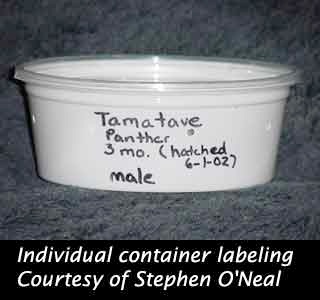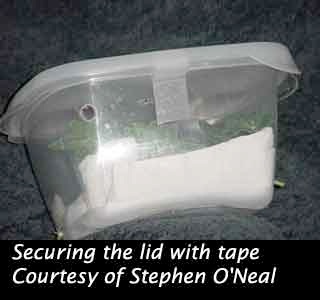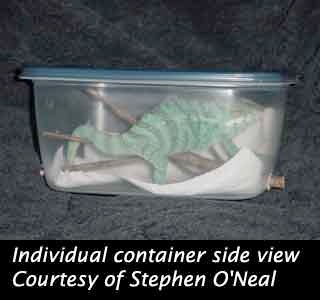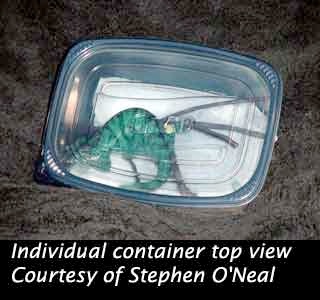



Shipping Chameleons
By Stephen O’Neal
Citation:
O’Neal, S. (2002). Shipping Chameleons. Chameleons! Online E-Zine, September 2002. (http://www.chameleonnews.com/02SepONeal.html)
Note from the CHAMELEONS staff:
This article consists of two parts - a text tutorial and a pictorial guide. The text will lead you through the steps involved with shipping and explain the details involved. The pictorial guide will show the process of creating the shipping containers to give a visual idea of what to do. To access the pictorial guide click on the black button at the bottom of the article. Now, please, enjoy this article written by Stephen O'Neal. Stephen is the owner of Natural State Chameleons and has logged an impressive number of shipments. We are proud to have his contribution to the EZine on this important topic.
Shipping Chameleons
The topic of shipping chameleons will most assuredly bring about as many opinions and preferences to the table as the number of most favored flavors of ice cream among individuals. Many people have reservations about shipping their chameleons, and understandably so. Many of us would never consider shoving our human children into a box, handing them over to someone we don't know only to be shipped half way across the continent through weather conditions that could reach well into the 100's (F) or well below zero. But rest assured, shipping chameleons is different and thankfully, they are much more suited to a shipping regime than many would realize and should fare very well - if YOU do your part properly. This article will cover aspects of shipping your chameleon, how to prepare the animal for the trip and items of interest that will make the whole concept of shipping chameleons less stressful on the animal and more pleasant for the shipper and receiver.
An initial disclaimer must be made so as to keep confusion and possible frustration (due to assumptions) to a minimum: whoever opts to ship a chameleon must first do their homework - every shipping company is somewhat different and, even among individual companies, rules are not necessarily applied across the board. After researching which companies do and do not ship chameleons, it became very clear that the policies within the various companies are not clearly communicated among their ranks. Even since the events of September 11, 2001 shipping anything requires patience and understanding and this rule certainly applies today with LIVE ANIMAL shipments. This article is geared towards shipping CHAMELEONS ONLY within the continental United States.
The first thing we need to cover is the human element. If YOU are dead set against shipping your chameleon via any method other than hand delivering, then that is certainly an option. There may be an arrangement that a receiver and sender can work out so as to "hand off" the chameleon at a convenient halfway point or other meeting spot. That method has its pros and cons, as does any other method of transporting your chameleon from point A to point B, but it is a valid option.
Now that you have decided not to drive 429 miles to deliver your chameleon to the new owner we can look at the major concern many people have when thinking about shipping their chameleon - STRESS!!! If anyone thinks for one second that shipping is not stressful on the chameleon then they would be sadly mistaken. However, we can certainly minimize that stress if we do everything we can to keep the process optimized for the animal's well being. The assumption is made from this point on that the chameleon being shipped is in tiptop shape. The overall health of the chameleon being shipped will strongly influence the outcome on the other end of the transaction - if you ship a sick, weak, unhealthy, parasite-infested chameleon your chances of telling a good shipping story will be very low. Many unhappy stories of a shipping procedure "killing" a chameleon float in and out of the chameleon community but in many instances the overall health of the animal was jeopardized well in advance of the chameleon entering the box. Simply put - don't ship a weak chameleon, the stress of the transit may be the proverbial nail in the coffin.
We have shipped over 1000 chameleons of various ages and amazingly we have lost only one animal during transit. Suffice it to say for now that IF you do what is needed then the outcome will most assuredly be positive for the shipper, the receiver, and most importantly, the chameleon.
Carrier mistakes do occasionally occur and they must be considered. Take for example an animal that is delivered to the wrong postal code - you would be surprised how many miles are between 64424 and 54424. Furthermore, accidents can happen with crushed boxes and extreme temperature exposure, but these issues are worst-case scenarios and any one of a number of 'bad things' can happen in transit. One must look at the odds and simply calculate the risks involved-a little faith and good fortune are always helpful as well. Although anything can go wrong during transit the shipper can most certainly decrease the odds that anything will go wrong by following a few simple concepts that will dramatically improve everyone's chances of telling a positive story. It is the humble opinion of the author that the ultimate responsibility is up to the person shipping the chameleon, and not the shipping company, if anything does go wrong. If the original shipper pawns the responsibility of a DOA off onto the shipping company, then the person who purchased the chameleon is probably out of luck. Many guarantees associated with non-receipt of perishable items being damaged are not applicable with most shipping companies when the issue of live animals are concerned-do your homework and find out what the policies are for the particular shipping company you choose.
Make sure, too, that both parties understand any guarantees and all other pertinent information related to the business end of the transaction. The details of any business deal should be spelled out very clearly so that both the shipper and receiver understands who pays for shipping, how payment is to be received (Money Order, PayPal, Cashiers Check, personal check, etc.) and when/where the animal is to be shipped. All of these factors should be agreed upon at the onset of the shipping process and need to be well understood by both parties. This aspect is critical because miscommunication by one or the other party may result in a shipment not being picked up promptly, no one being at the shipping address to take receipt of the animal, confusion as to what to do in the case of a DOA, or any one of a number of other "issues" that can be avoided by some simple communications between the shipper and receiver. Work these details out well in advance of the chameleon ever seeing the inside of a shipping container.
United Parcel Service (UPS), Fed-Ex, Airborne Express, United States Postal Service (USPS) and Delta PetFirst (formerly Delta Dash) are all reputable shipping companies and can be contacted to find out what they need on file prior to your attempts at shipping. Be prepared for some confusion among these companies about their specific policies - they change from time to time and what may be an avenue to ship today may not be tomorrow - so be patient yet persistent. Regardless of the company, choose one that will guarantee Next Day Delivery or Same Day Service and preferably the delivery to be made prior to 12:00 noon. Ask to speak to a customer representative who can answer your specific questions. You may need to call several people with a company before you get the answers you are seeking. Sometimes the process of clearing all the associated paperwork can take some time (weeks) so make sure you are well-prepared in advance of shipping and you have all the details worked out with the company-once again, the key is to be patient yet persistent. Candidly, the overall description of the shipping situation here is total chaos. Calling several people at different times and different locals for each company (with the exception of USPS and to a degree, UPS) resulted in many different answers. So please keep that in mind when studying the descriptions given below.
Fed-Ex: Evidently, there are only 7 companies that have authority to ship live animals and most of these are insect suppliers. A legal waiver must be obtained to absolve Fed-Ex of all legal issues and supposedly this is very difficult to obtain. I didn't pursue it any farther as I had more than one employee say the same - BUT there may be a way to ship with them SOMEWHERE! As with all companies, it never hurts to simply ask if they will ship your chameleon; on any particular date with any given personnel you may get lucky.
USPS: Anyone can ship IF they meet the following criteria:
-
•Animal can't exceed 20 inches in length (as of June 30, 2002)
-
•The package must be able to reach the destination in good condition during
normal transit time (so send it Express Delivery). -
•The animal must not require food, water or attention during transit.
-
•The animal must not create sanitary problems or obnoxious odors.
-
•Packing container must have 275 lb. test strength, double wall, water resistant
cardboard or fiberboard box or equivalent and be adequately vented.
Express Delivery shipments should arrive the following day if the package being shipped arrives prior to 3:00 p.m. (in most instances) at the origin locale. These rules were updated as of July 27, 2002.
Airborne Express: They will ship tortoises, frogs, non-venomous insects, crustaceans, and worms and everyone I called (4 different people at varying levels) said they would not ship lizards of any kind. BUT we know of one particular pet store that uses them to ship various non-venomous snakes, lizards, etc - so here again, the info is shaky, at best, even though I've tried and tried and tried...
UPS: You must have a valid account with them BEFORE attempting the process. There is no cost to set this up but you must fill out the paperwork associated with getting an account set up. You must make a special request through the local customer service representative to ship live animals and then:
-
•You must meet the minimum specs to ship live animals (very much like the
USPS list). -
•They will gather information about the type of animals being shipped.
-
•Must certify how the shipping is prepared...container, packing material, box
strength, etc...they may take pictures of your boxes and all associated packing
material. -
•A form must be signed then they submit it to their authorizing personnel.
-
•You will receive a letter of authorization to ship live, harmless lizards if all
paperwork is cleared. -
•UPS is absolved of all liability-and the contents are non-insurable.
The time delay involved to become approved to ship live animals should be anticipated and therefore getting the process started well in advance of shipment is a good idea and recommended if UPS is to be used.
Delta PetFirst: They are not known as Delta Dash anymore because the ticket counter doesn't take the packages, but the same service is offered (basically linguistic gymnastics and shorter lines for real customers). After calling four different people this was the best answer I received. As of 2 months ago, they would not consider shipping anything LIVE unless you were a Verified shipper...2-6 week process on average. Now, as long as you have the animal in a container that can be visually inspected prior to taping the box shut (such as a clear plastic container or a bag that can be opened OR if it can be removed for visual inspection) they will ship after the Endorsement Certificate is granted and signed. You must have a valid photo document from a governing agency. And absolutely no snakes or venomous reptiles (referring to, perhaps, the Gila Monster).
The worst case scenario I encountered was, "We do not accept live animal shipments of any kind unless you are a verified shipper and that is a process that can take as long as 10 weeks and we will need to inspect your facility, get an authorization statement and then you can ship if you are approved and verified." Good grief! The inconsistencies were unbelievable. One said, "Yes, we ship live animals. Bring the animal down and we'll do it." Another person said," Don't even bother to come." Both responses came from the same office, in fact! All this being stated, it would be best if you were considering Delta to go through the process to become verified. This basically entails a site visit by Delta personnel to your address to look at the shipping container, packing material, animals to be shipped, etc. Once the paperwork is filled out and the time has elapsed for the paperwork to be approved, you will be granted Verified Shipper status. Then a shipping container that is completely closed and ready for shipment can be taken to the shipping counter without much worry that they will reject the shipment. The time delay involved to become Verified should be anticipated and therefore getting the process started well in advance of shipment is a good idea and recommended if Delta is to be used.
Once you have clearance to ship live animals the process should not be complicated from that point on. It's just getting your foot in the door! For the normal "Joe Blow" off the street with little incentive to ship - few would find this process "worth it". USPS is the only exception to the non-runaround mentality BUT remember, they are overwhelmed with business and could potentially have a higher percentage of mistakes. In all actuality, it is a risk/benefit analysis that the shipper needs to calculate. I would not recommend one company over the other at this stage, but rather would encourage anyone who will be shipping in the future to get started working with their company of choice well in advance of the actual shipping date.
A word to the wise: DO NOT attempt to sneak animals in as perishable "chocolate" or fragile "glass". We have heard of people doing this over the years and it only jeopardizes your reputation with the shipper and it also puts a blemish on the entire chameleon community if your sneaky lie is discovered - just don't do it. You will sleep better at night knowing you were honest and the entire process is on the up and up.
Prior to boxing up your chameleon, call the shipping company and determine the latest possible time the box can be brought in that will guarantee Next Day Delivery. Many companies will also pick up the package from your address but this will undoubtedly add several hours to transit time. So, if at all possible arrange to deliver the animal to the shipping counter at a time specified by the personnel to be the latest time that will still guarantee Next Day service. If, for example, the shipping company's doors close at 6:00 p.m. then try to deliver your box just prior to that time. This will keep the time the chameleon is in transit to a minimum. Otherwise, will be packing the animal in the morning, dropping it off at the carrier and the animal will sit there for 8-10 hours before it even starts the real journey. Simply try to keep the time the animal is out of its habitat to a minimum.
Once a shipping company is chosen, and the appropriate account paperwork is filed with them to ship LIVE ANIMALS and you are approved, we now come to the portion where the details become apparent. Don't be intimidated by the minutia, most of the items discussed are common sense but they need to be covered nonetheless.
To prepare your chameleon for shipment, we prefer not to feed the chameleon on the day of shipping. If the chameleon were to become extremely stressed during the packing period, it may regurgitate and, in fact, could aspirate initiating respiratory difficulties. Ample watering, however, is recommended and will ensure that the chameleon is well hydrated in case the package takes more than just an overnight trip - a day without water is not detrimental to a traveling chameleon - you must remember that reptilian metabolism is low so water loss will be minimal. The chameleon will be sleeping during transit so very little water will be lost through respiration. If the package is lost for one reason or another and it takes a day or two additional for it to reach the destination, you want the odds to be in the chameleon's favor for survival, and hydration is paramount. One need not worry about all that CAN go wrong but you must prepare as if it WILL--better to be safe than sorry.
If you have your chameleon in an indoor cage and the photoperiod is regulated exclusively by timed lighting, we recommend a "short day" and turn the lights off an hour or two prior to placing the animal in its shipping container. This will basically have the effect of causing the chameleon to go into the sleep pattern somewhat early in the day. The chameleon will wake up for a very short time when you remove it from the cage for placement into the container and the stress of that move can be lessened if the animal is already cooled down and perhaps already asleep. Once the chameleon is in its container for shipping, keep it dark so the animal can return to a sleep pattern.
Now that you have your chameleon prepared for shipping, we must discuss the materials you will need to properly ship the animal.
The shipping container that has been mentioned can take several forms. We have seen animals shipped in muslin (cloth) bags, paper bags, Styrofoam cups, plastic cups, aspirin bottles, ice cream containers - you name it. We recommend plastic containers (depending on the size of the animal) with holes pre-punched, poked or burned into them for ventilation. For small chameleons, an 8 oz. container can be used and for larger animals, larger containers are obviously needed. Basically, the container should be just large enough for the animal to fit into and assume a comfortable resting position-measure the animal when resting and gauge the container by the amount of space it occupies while asleep. We don't recommend a container that is too large - the "slosh factor" is reduced if the container is large enough for the chameleon to fit in but not so large that it could invite several friends in and have a party - the chameleon will be sleeping, not moving around, so keep it small. We place a paper towel in the container that has been sprayed ONE time with a fine mist of water. This will keep the humidity up in the microclimate directly surrounding the animal. If the chameleon is very small, it can hold onto the towel and that is typically sufficient. If the animal is larger (over 3 inches snout to vent length) then secure a piece of plastic vine or a stick into the container which will not move while in transit - this will give the animal something stable to grasp and sleep will soon follow. The lid will snap on but place a strip or two of transparent tape to secure the lid, just for added insurance. Finally, label the container with the relevant information (species, morph, age, sex, etc.) so the receiver will know exactly what animal is in that particular container. This is especially important if multiple animals are shipped in the same box.
The box: just some advice - don't go rummaging through a dumpster behind the local grocery store for "the perfect chameleon box". If you are going to ship your chameleon half way across the United States, do it right and buy a NEW box from the shipping company or a local container manufacturer that has a crush rating of at least 200 PSI Bursting Test strength - typically printed on the bottom of each box. Choose one that will allow the plastic shipping container to "float" in the middle of the box with at least 2-3 inches of space on all 6 sides for shredded paper, peanuts or crumpled paper to be stuffed around the container (shredded paper works well. If you don't have a shredder most business offices would be more than happy to provide you with all the shredded paper you could ever want). The cardboard box will be strongest and provide the most cushion area in the interior if it is fairly equal in height, width and length. In other words, a cube. If it is available, purchase a box with a 6-sided liner made of at least 1⁄2" Styrofoam (if one is not available for purchase you can make your own liners from Styrofoam sheets - 3/4" recommended-- cut with a table saw, jig saw or electric carving knife and custom fit each box with tight-fitting sides). The Styrofoam serves a dual purpose. It not only provides an insulatory effect from heat in the summer and cold in the winter but it also adds a substantial amount of crush resistance. Finally, label the box prominently; in fact, we label our boxes blatantly. Let the shipper know that there is a LIVE CHAMELEON in your box. Large letters stating LIVE, HARMLESS CHAMELEON, PROTECT FROM HEAT AND COLD, PLEASE HANDLE WITH CARE or even a picture of a chameleon printed off on your home PC and taped onto the box is encouraged. You will be surprised at how curious the shipping personnel may be. A picture is worth a thousand words towards developing a good shipping relationship with the carrier. The carriers are usually intrigued with these wonderful animals. Take the time to develop a relationship with the shipping company. If they know the box contains an incredible animal, they will be much more likely to handle it carefully. Obviously, you should tape the box adequately with approved packing tape (no masking, electrical or duct tape) and one or two holes should be poked into the box prior to placing the chameleon into it - this will supply plenty of oxygen. Remember the low metabolic rate of chameleons and keep the number of holes to a minimum.
Weather is a factor that can make shipping your chameleon very "interesting". If the low temperature at the origin site is 36F degrees and the destination spot is supposed to hit 102F the next day, some forethought and ingenuity must be applied. There are products such as heat packs and cool packs that may or may not need to be utilized, depending on the weather at the origin, destination and everywhere in between. Heat packs such as the ones pictured can be purchased for relatively little and can last from 4 hours up to 60 hours and ice packs of varying sizes can be purchased as well which have varying efficacy times depending on size and ambient temperature. Some experimentation with these products is recommended prior to use (wrap the heat packs in various layers of newspaper or paper towel to allow for varying levels of heat disbursement and place the ice packs in at least one zip loc bag to minimize the chance of leakage within the box). Test the temps you get over the course of 12 hours. Keep in mind that warm air rises and cool air drops, that fact can influence how you place your heating and cooling packs, the time of efficacy, the time when they are needed, etc. For example: If the origin point is supposed to dip into the 40s at night and the destination is supposed to hit 99 degrees then a short duration (8hr) heat pack could be placed toward the top of the box with the animal below that, separated by shredded paper---the rationale: the heat will be needed most within 4-8 hours of the initial trip, the pack will release the majority of its energy within that time frame, the ambient temp of the box will be increased enough to keep the animal warm at the onset and that will eventually dissipate prior to the time the box arrives at the destination terminal the next morning (whatever little heat may be emanating from the pack will be going "up" and not directly into the animal's shipping container). Knock on wood, the only DOA we have had came not because a shipment was delayed, as it was sent Same Day Air Delivery. And not because the weather was inclement during the month of February but rather the chameleon expired due to heat exposure from an improperly placed heat pack. An unfortunate and sad but valuable lesson learned. Just make sure you have checked the weather forecasts for the destination and origin spots (http://www.weather.com) and adjust your packing materials accordingly and with forethought. If the temperatures are moderate and are within the limits of your chameleon's highs and lows for optimum health - no heating or cooling packs should be needed.
Principal to the success of shipping chameleons is the complete understanding of all parties involved that a LIVING ANIMAL is going to be shipped and a LIVING ANIMAL should be received. In other words, the receiver has the responsibility of taking IMMEDIATE delivery of the shipment once it arrives at the destination address. If the carrier is forced to put the box back on the truck or leave it on the doorstep because no one is there to receive the shipment the animal is put into jeopardy. It should be a no-brainer issue that someone is available for receipt of the chameleon, but never assume the obvious. If the shipper does their part, the carrier does their part, and the receiver does their part then the chameleon being shipped will be very little the worse for wear and the story of the cross-country chameleon will be a positive one indeed.
Learn from others. Don't reinvent the wheel but rather follow some of these general guidelines and you will find that shipping chameleons is not as bad as you might have thought. A little pre-shipping research and some effort can go a long way into making a long trip very rewarding for the shipper and the potential new owner of the long-tongued jewels you have worked so hard to care for and raise.

Pictorial Guide To Shipping Chameleons
Individual Container For Babies:




Individual Container for Adults:






Contructing the Shipping Box:




Packing the Shipping Box:






Stephen O’Neal

Stephen O'Neal and his wife Aleshia own and operate Natural State Chameleons-a humble operation that they say enriches the lives of their family (3 children) and all those who visit their "menagerie". Stephen serves as a Research Biologist for the AR Game and Fish Commission and, along with many other facets of the position, gives presentations statewide with the native herpetofaunal collection (over 40 species) that he keeps and maintains.









Join Our Facebook Page for Updates on New Issues:
© 2002-2014 Chameleonnews.com All rights reserved.
Reproduction in whole or part expressly forbidden without permission from the publisher. For permission, please contact the editor at editor@chameleonnews.com
